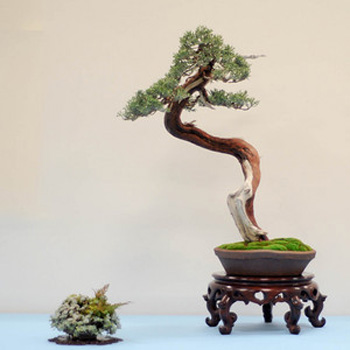
I lifted this sinuous Ponderosa pine (Pinus ponderosa) off a great gallery at Bonsai Tonight from the 2010 Bay Island Bonsai Exhibit. Though I can’t tell for sure, it looks like at least five full twists in the trunk.

Here’s another heavy-trunked bunjin. It’s a Sierra juniper, also known as Western juniper. It and it’s close cousin, the California juniper are becoming favorites of bonsai enthusiasts here and abroad.
It’s good to see is the use of native trees and their increasing acceptance as subject for high quality bonsai. I can remember a day when almost all specimen bonsai were Japanese varieties. Because the Japanese varieties set the standard, recognition of other varieties as potential subjects for world class bonsai has taken some time.
All of the trees shown here were collected from the wild. In Japan almost all of specimens worthy of collecting have long been dug up.

California live oak (Quercus agrifolia). Another native tree with numerous features that make for great bonsai. In some ways it reminds me of the ancient olives that are everywhere in Spain and that makes it such a great bonsai. Like those olives, live oaks are abundantly omnipresent in much of California.

This one is labeled Cork oak, but should be distinguished from the actual Cork oak (Quercus suber) that wine corks come from, which is a European native. Though the photo is too small to tell for sure, I would bet that it is a California live oak that has ‘corked up’ with age. These corky live oaks are often called cork oak in California. If you look at the live oak above, it appears to be corking up some too.
No comments:
Post a Comment